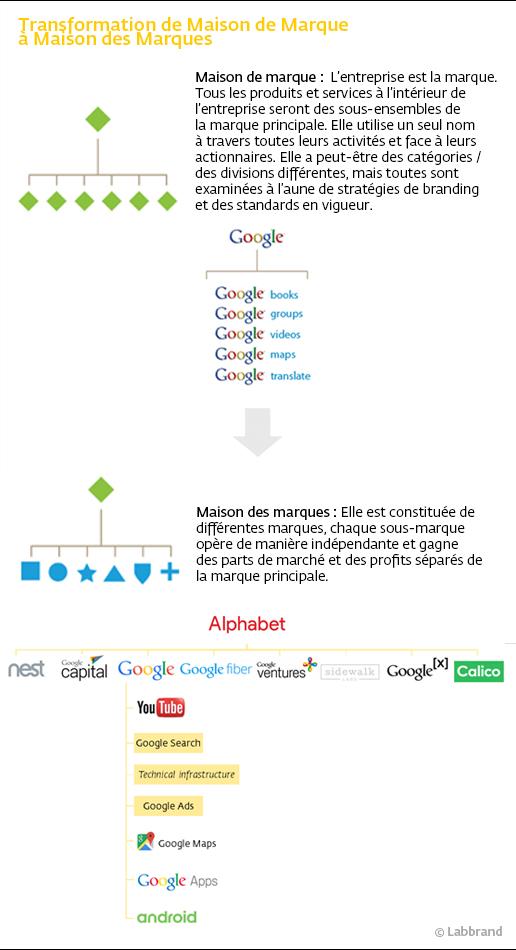

In a revolutionary move on August 10th, 2015, Larry Page announced Google’s brand architecture transformation, creating the innovative holding company, Alphabet. This restructuring separates diverse business units from Google, with the new search-centric Google remaining the core of Alphabet. G is for Google, and the conglomerate includes subsidiaries like Calico (biotech), Nest (smart home), Google Fiber (internet and cable), Google Capital (capital fund), Google Ventures (venture capital), and Google X (breakthrough tech lab). Explore this groundbreaking brand architecture shift, reflecting Page’s belief in revolutionary technology.

HOW DOES THE NEW CORPORATE STRUCTURE IMPACT GOOGLE?
The restructuringof Google has raised worldwide discussion and speculations.
In a strategic move highlighted by Harvard Business Review, Google’s brand architecture restructuring, creating Alphabet, promises enhanced transparency in business performance. This adjustment addresses the previous ambiguity for shareholders, as diverse businesses were consolidated under one roof. Now, individual subsidiaries can offer transparent performance reports, mitigating the potential negative impacts on Google’s core web services business. This operational shift not only fosters clarity but also led to a notable 7% surge in Google’s shares on the announcement day. Explore the profound implications of this brand architecture adjustment on Google’s overall business dynamics.
Alphabet’s brand architecture marks a strategic liberation for Google, injecting vitality and an entrepreneurial spirit. This restructuring empowers Google to revive its roots as a pioneering technology startup, fostering creativity and a revolutionary mindset. According to US analyst Roger Kay, this new infrastructure provides Google with unprecedented freedom and flexibility. Units can be adjusted dynamically, scaled up or down, and strategic partnerships or separate companies can be formed. Explore how Alphabet’s brand architecture not only breaks free from redundancy but also propels Google into a more agile and innovative era.
BRAND ARCHITECCTURE TRANSFORMATION
As an explorer of brand building, we hope to share our insights from a branding perspective. This decision of Google/Alphabet is in fact a typical brand architecture development, which in this case is a transformation from Branded House to House of Brands (see below).

The previous Branded House architecture has helped Google to grow from a startup to the fifth-largest technology company in the world. ‘Initiating innovative ways to significantly improve the quality of life’has been Google’s motto since the very beginning.Google started out focusing on one core business, web search, and made it unparalleled. At the same time, Google has always beena pioneer inemerging markets, encouraging an innovative company culture and a dynamic market, in order to continuously launch new products that respond to consumer needs. With Information set as its core, Google has launched extensive innovative services, including Google Books, Google Maps, Google Translate, Google+ and more. These diversified service offerings were clearly demonstrated through its Branded House brand architecture, which allows Google as the master brand to enrich its brand assets, enhancing its brand extensiveness and impact. This is a demonstration of the key advantage of a Branded House architecture – when a brand is at its initiation or accumulation stage, thisframework will help to reduce marketing budget for new product launches, and more importantly, it willbe beneficial in establishing a consistent corporate culture andemployer brand as well as in stabilizing the key leadership team.
It is clear that success usually leads to the expansion of a company’s size and the complication of its structure, especially for Google who has been fast expanding and acquiring many new businesses in recent years.It seems that Google is experiencing its heyday, but the founder foresees the potential challenge– ‘Under the current circumstance, no matter how successful we (Google) are, still being seen as a purely searching engine corporate will be our biggest obstacle to develop.’ On one hand, with the constant expansion of company scale and business scope, Google’sidentity is blurring. People become confused about who Google is and what it does. Everyone sees a different Google. Investors see a profitable technology company; consumers seea search engine; while tech enthusiasts see innovations. On the other hand, Larry only stated one side of the story.Our takeawayis that the business of search engine is becoming the same old advertising business. It’s no longer perceived as innovative, pulling Google away from its innovative roots.This is the very moment that Google needs to adopt an effectivewell-defined brand architecture.
The existence of Alphabet complies with these needs, and without doubt, it helps Google to become ‘lean’. The transformed brand architecture not only actively respondsto some existing problems (e.g. tax, capital market, innovation etc), but also redefinesits mission and values – we are not a company with one sole business, but aninnovative technology company that is meaningful to people’s life. The transformed Google, now Alphabet,is present in a variety of fields, from media to self-driving car, life science to smart home automation.
The transformation from Branded House to House of Brands primarily brings higher freedom to all of its sub-brands. It is a transformation from a centralized system to a more flexible one. After detaching from the old Google brand, all subsidiaries will be able to operate independently, reposition or redefine their value chain. Theywill be much less affected by Google’s resources and brand image. The creativity and vitality of the brands in emerging industries will be stimulated. Correspondingly, the new Google, stripped to its core business,will become more focused. Because it already has comprehensive understanding of the existing market, it could further developand innovate.
Of course, it is inevitable that such transformation wouldcreate certain challenges. Each sub-brand will need to rebuild its image and impact. They will also have to competewithin its own field all by themselves as Google is no longer their endorser.
CHOOSING A BRAND ARCHITECTURE
There is no good or bad brand architecture, just a suitable oneor not. Over time, brand architecture also should not be static. As a brand owner, we should pay extra attention to themotivations behindchoosing one brand architecture framework. This decisionshould be prompted by understanding the market, forecastingfuture development or answering a simple yet profound question of Who am I?
The establishment of Alphabet serves as a pivotal solution for Google, addressing various practical challenges. Beyond reassuring investors and fostering operational transparency, it opens avenues for talent and significantly boosts market valuation. While recognizing that Alphabet is just one facet of Google’s solutions, it stands as a crucial demonstration of the profound impact brand architecture can have on a company’s operations and development. Explore how this strategic move not only resolves immediate concerns but also charts a transformative course for Google’s future trajectory.
A Labbrand Group Company © 2005-2024 Labbrand All rights reserved
沪ICP备17001253号-3* Will be used in accordance with our Privacy Policy
To improve your experience, we use cookies to provide social media features, offer you content that targets your particular interests, and analyse the performance of our advertising campaigns. By clicking on “Accept” you consent to all cookies. You also have the option to click “Reject” to limit the use of certain types of cookies. Please be aware that rejecting cookies may affect your website browsing experience and limit the use of some personalised features.